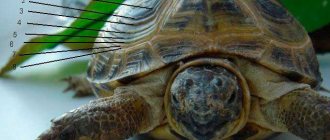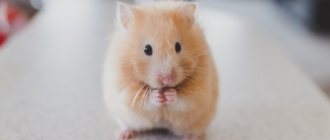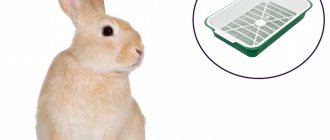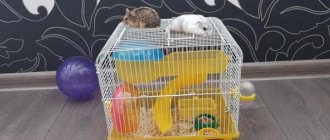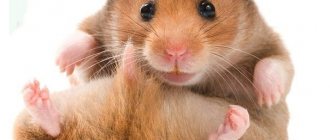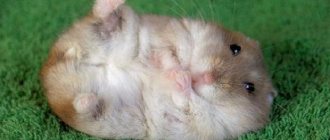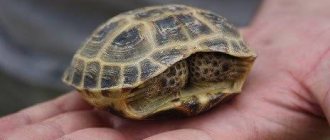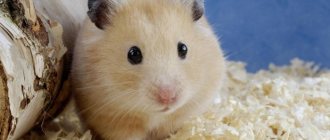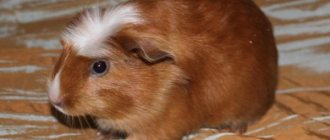- home
- Acquisition
16.07.2018
One of the most important points when purchasing any pet is determining its age. The store can sell an adult animal under the guise of a young one, which will reduce its lifespan for its new owner. Since the estimated lifespan of a hamster is 2 years, you need to be sure of the animal you choose. In order not to be deceived and not to get into an awkward situation, the buyer himself must be able to recognize the age of the hamster.
It is very difficult to determine the age of a Djungarian hamster with absolute accuracy, even for a good specialist, so they always speak approximately. Typically there are three age stages: young, adult and old. In no case is it recommended to buy a baby younger than one month, since at this age it is still too small and will have to be fed manually with a pipette and at frequent intervals.
What can you say about the age of rodents?
Since this type of rodent does not live long, they begin to reproduce when they are only a few weeks old. For example, Djungarian hamsters can produce offspring already when they are three weeks old.
But despite this, experienced specialists are skeptical about early mating. And all because up to six weeks the animal’s body develops at incredible speed. Very young females are sometimes not ready to give a lot of milk. And this may cause the death of the cubs.
In addition, babies of young mothers may be born with all sorts of abnormalities. It also happens that females eat small hamsters. Therefore, animals should be mated at about three months. But at the same time, the first mating should occur no later than six months of age.
It is also important to understand that at least three months must pass between matings to restore strength. Therefore, the second time the female can begin to prepare to become a mother at eight to ten months.
Veterinarians are confident that animals of this species should breed at approximately the age of three months to one and a half years. At the same time, some females lose the ability to reproduce at about one year. Males are capable of reproduction throughout their lives. And they are recommended to participate in mating from five months.
Age categories
Experts say that you don’t need to pay attention to just one indicator. Depending on the breed and physiological characteristics, the number of years they live can vary significantly even among rodents of the same size. It should be understood that the exact period of life, namely, how old the animal is, how many months, and even more so, how many days it has lived, will not be determined even by a specialist who has been breeding these small rodents all his life. You should also understand that even with careful diagnostics, you will be able to determine the approximate age of hamsters.
It is not difficult to distinguish a newborn from an adult. But already in a month it will be very difficult to give an accurate visual assessment. For convenience, professionals divided them into 3 categories:
By these standards, babies are representatives who are no more than 4 weeks old. This period is not suitable for acquisition, since the baby is still too shy and is not used to living without maternal care.
Individuals that are between one month and one year old can begin to be considered adults. This period is considered the most favorable for purchasing. These animals will become more independent. At the same time, they are easy to tame, and they will live with you for a long time.
Well, old people are considered to be those representatives who are about 2 years old, or even a few younger rodents can be included here. The only downside to these rodents is that they will die very quickly after purchase. If you are ready for this, then you can safely give preference to the oldies.
Newborn rodents
After giving birth, the female actively protects and protects her cubs. Therefore, she should not be disturbed too much for about two weeks. But at the same time, the owners must examine the offspring. And, if there are dead puppies, they should be removed using a damp cloth.
Babies must be fed mother's milk, which contributes to their rapid growth. They become covered with fluff around the fourth day. And a day later, the animals begin to hear sounds. At the same time, the eyes of young rodents open only on the fourteenth day. But they begin to move actively while still blind.
And by one month the baby’s weight is half the weight of an adult animal. And they grow up to five to six months. And therefore, at six months, a hamster is considered to be a full-fledged adult animal. Since these rodents live very short lives, they begin to age at the age of eighteen to twenty months. If young individuals actively gain weight, their weight can often decrease significantly during the aging process.
When is the best time to buy?
When choosing a good pet for yourself, it is better to give preference to young individuals, but which can already feed on their own and do not need breast milk.
The best age would be 1-3 months; it is better not to purchase a younger pet. For breeding, six-month-old individuals are selected. There is no need to purchase a pet older than 10-12 months.
Choose active hamsters with shiny, clear eyes and thick fur. If you see bare ears or lethargic behavior, dull fur, it would be better to abandon this individual.
How can you find out the age of an animal?
There is not a single method that allows you to determine the age of a rodent down to the day. Therefore, it is determined with an error of several weeks. There are no more accurate methods, even among experienced specialists. Depending on their age, hamsters are considered young, adult and old. At the same time, they begin to eat independently after one month from birth. Therefore, before this age, rodents are with their mother and are not sold. After all, if they do not have the opportunity to consume mother’s milk, then a person will have to feed them milk using a pipette. This method is quite difficult. Therefore, such young individuals are separated from their mother only in exceptional cases.
And you can determine the approximate age of a small decorative pet animal by the following characteristics:
- Young hamsters are very active and cheerful. They begin to move a lot, go about their business, play and eat almost immediately after waking up. But old animals, regardless of breed, sleep a lot, and their activity at any time of the day is significantly reduced.
- You can tell how old an individual is by looking at the fur around its ears. The ears of young animals are covered with light-colored fur. And older animals have practically no vegetation in these places.
- The age or illness of an animal can also be shown by the eyes. The eyes of a healthy and young hamster are clear and shiny, while the organs of vision of an elderly animal or one suffering from various serious diseases are clouded.
- Babies are completely covered with fur by the fifteenth day of their life. At the same time, it has a bright color and resembles fluff. If there are bald patches on the bright fur of the animal, then this may be a sign of molting or illness. In addition, this sign often indicates that he is less than one month old.
- You can also determine the age of a small decorative rodent by its weight. If an individual is less than three months old, then it should not weigh more than forty grams. This applies to babies of almost any breed. Therefore, when purchasing a pet, it is recommended to weigh it.
Lifespan of a cat
How long will your cat live is a question to which there is no exact answer. Life expectancy depends on living conditions, health problems, genetics and even breed. Typically, domestic cats live an average of 13 to 18 years, with many crossing the 20-year mark. Street stray cats are more likely to face threats to their lives: diseases and accidents, and live shorter lives - on average about 10-12 years.
Comparison table of feline and human ages
Physiological signs of age
Cats do not show visual signs of aging like you and I do—wrinkles, gray hair. But the body, unfortunately, cannot hide its age. Therefore, you can understand that your cat is no longer as young as it seems without doing any calculations.
- Teeth
Teeth are a great indicator of age. Older cats tend to suffer from tooth decay and tartar more often than younger cats. Kittens' teeth begin to grow between the second and third weeks of life, and are fully grown by about four months. If you look at a cat's teeth and see their whiteness and absence of caries - the cat is probably about a year old, yellowed teeth indicate an age of two to three years, affected by tartar - four to five years, and the absence of some teeth and poor condition the rest makes it clear that this is a rather elderly animal.
- Body
Young cats are active and mobile, their muscles work every day, they are fit and strong. Older cats, as a rule, become calmer, lethargic, their muscles lose strength, and their skin begins to sag.
- Wool
Healthy young cats have a fine, soft and shiny coat, while older cats lose their beauty and become thicker and coarser. Some cats may become noticeably gray.
- Eyes
Bright, clean, clear and healthy eyes in our young pets become cloudy and faded over time. The iris of the eye takes on an uneven, jagged outline. Such changes occur when a cat crosses the 10-year mark (57 years by human standards).
- Hearing
Just as some people begin to lose their hearing as they age, cats suffer from it too. This doesn't happen to every pet, but it is quite common. Deafness varies in severity: for some cats there are minor changes, and for some, old age means complete loss of hearing - deafness.
- Nutrition
An older cat eats much less or more slowly than a younger cat. This occurs due to a slowdown in the digestive system and metabolism. Processing food becomes a difficult task for a weakened body, which is why older cats are prone to weight loss.
Other signs of aging include: decreased sense of smell, increased sensitivity to light, cardiovascular problems, brittle bones, irritability, trouble sleeping, and decreased immunity.
© Lifeo.ru
The age of hamsters in human terms
Given that such rodents live, as a rule, no more than two or three years, their years can be easily converted to human years using understandable mathematical calculations.
At two years old, a pet is believed to be approximately sixty human years old.
In addition, experts have calculated the approximate age of the animal during the following periods of its life:
- at six months a hamster is approximately the same as twelve years for a human;
- in a year he can be called an animal in full bloom;
- after one and a half years, active aging of the individual begins.
Despite the fact that old age and death are inevitable for any living creature, its activity and life are easy to prolong with proper care. Regular examination by a veterinarian will allow timely recognition and treatment of many rodent diseases. Therefore, until old age, many of them can remain very active and cheerful.
How to find out how old a hamster is by human standards
The lifespan of hamsters is short. The number of years these rodents live depends on the breed, nutrition, care, and also on the conditions in which the hamster lived before it came to its owner.
The average life expectancy of dzungariki in the wild is 1.5 years. At home, where there are no predators, bad weather, but there is always food, they live 2–2.5 years.
Syrians are considered to be the real long-livers among hamsters. They usually live for about three years, but with good care they can live up to 4 years.
Every owner wants to know how old their hamsters are in human years of life. Scientists believe that a 2-year-old hamster is already approximately 60 years old by human standards.
Thus, the age of these rodents at various periods of their lives can be easily calculated in terms of human age. For ease of perception, these data are presented in table form.
| Hamster | Human |
| 0 days | 0 days |
| 15 days | 8–10 months |
| 6 months | 12–14 years old |
| 2 years | 55–60 years |
| 3 years | 75–80 years |
Morphological indicators
You can also determine the period of a hamster’s life by its external characteristics.
By wool
At a minimum, you need to pay attention to the wool. If it is not there yet or has just begun to emerge, this means that the rodent is less than 2 weeks old. Full hair appears in the 3rd week of life.
Young individuals have brighter colors. This can make it clear the real period of life of a particular animal. Also, young representatives may have bald areas. This suggests that you can safely buy it. He is already old enough to live independently.
You should also pay attention to the inside of the ears. In young representatives it is covered with fine hairs. The old animals do not have fur in these areas.
By jaw
Particular attention should be paid to the jaw. Rodents that are too small or too old may lack teeth. If the life period is from 4 weeks to a year, then they will have several teeth. The bottom tooth usually appears first. Therefore, if you come across such a rodent in a store, you can safely take it home.
You can also determine the age of a hamster by its eyes. If the animal has bright and shiny eyes, this indicates that it is young. When the eyes are cloudy, this means that he is most likely sick or will die soon.
Proper inspection
Before you begin the examination, the hamster needs to be calmed down. To do this, just pet him, and you can talk to him in a calm voice. Give your baby a small piece of his favorite treat.
To avoid possible injuries if the rodent suddenly escapes from your hands, it is better to inspect it over something soft. Place a towel or blanket folded in several layers on your knees.
Take the hamster carefully, but you need to hold it tightly so that it does not escape. To do this, place the animal on your left palm with its belly down, and with the thumb and forefinger of your right hand, grab it by the fold between the shoulder blades. This will help fix the animal in the desired position. The animal will not be able to turn its head and bite its owner. Carefully turn the hamster onto its back and begin the examination.
Finding out the gender is important, even if you plan to keep only one hamster. This is necessary in order to give the rodent a name.
If you buy an animal for a child, he will definitely ask you whether it is a boy or a girl. In pet stores, keep animals in one cage. Therefore, careful attention to the gender of the hamster will allow you to avoid buying a pregnant female.
How to determine the sex of a Dzungarian
Djungarian hamsters are one of the cutest and funniest pets. They bring a lot of joy, and caring for these babies is easy. Examining the dwarfs, placing them on the palm of your hand with their belly up, you can notice the following differences:
- From the age of four weeks, boys have visible testicles near the base of the tail; they stand out especially well when gentle pressure is applied to the abdomen.
- The distance between the penis and the anus in adult hamsters is one and a half centimeters, and in babies it is three times less. In females, the distance from the genitals to the anus is only 3 mm.
- Males have a gland on their abdomen that resembles a navel, with which they mark territory.
- The back of a male dwarf is pointed, while that of a female hamster is rounded.
- Females have 8 nipples on their tummy, arranged in pairs.
- Females are larger and more active than males. Usually they do not want to be handled; they often express their protest by biting the finger.
Their sex can be determined by the length of their fur - males have a much fuller and longer coat.
Do not pick up small dungarian hamsters - otherwise you will feed them yourself
Female Djungarian hamsters usually give birth to 4 to 6 babies. On the fifth day after birth, babies acquire soft fluff; on the 10th day, the fur is already quite thick; by this moment the eyes also open. On the 20th day, the offspring of dwarf hamsters can be separated from their mother. To the pet owner
It is worth knowing that the cubs do not feel the danger of falling from a height: when they reach the edge of a shelf or table, they move further and can be very seriously injured when falling. Therefore, the cage should always be closed.
Newborn babies do not squeak only when they feel proper care from their mother. They begin to make shrill sounds when the mother does not feed or lick them. When going out to get food, the furry mother always covers the “kindergarten” with soft bedding.
Healthy Djungarians actively move their mouths and limbs, trying to find mother's milk.
On the sixth day after birth, the cubs begin to squeak sharply and demandingly, demanding their mother’s attention. This goes away with age.
Babies develop quickly: the red color of their skin becomes less intense, and already a day after birth, the future color is visible on their body (for now this is only skin pigmentation), and after a week they are covered with soft brown fluff.
There are often cases when, when the second litter appeared, the grown-up cubs from the first still remained in the parental cage, and then, after the appearance of the third generation of babies, the adult animals from the first litter ate the newborns. For this reason, young animals are always separated when they reach independent age. There is no way to allow overcrowding in a cage.
The owner should not hold newborn hamsters, otherwise the female, sensing someone else's smell, will refuse the children. Only when the dwarfs are two weeks old can they be touched. At the same time, their gender can be determined.
General rules for determining sex in hamsters
To determine the sex of a purchased hamster, you need to carefully examine it. This is not an easy matter; a pet that is not accustomed to handling can resist and bite painfully. Therefore, for the safety and effectiveness of the inspection, it is important to adhere to the following rules:
- The procedure must be carried out in a calm, relaxed state of the pet in order to avoid its aggression and attempts to escape. It is better to treat the baby with a treat before this, pet him and calm him down.
- It is more convenient to do this on your knees, laying a terry towel on it. During examination, you need to hold the hamster firmly, but carefully.
To determine the sex of a hamster, the following details are important:
- Dimensions. Girls are always slightly larger than boys; it is convenient to distinguish gender by this characteristic when there are several individuals.
- Back shape . In males it is narrowed towards the tail and raised upward, while in girls it is wider and rounder.
- Sexual characteristics . Boys have a pair of almond-shaped testicles on their butt, while hamsters have a smooth one.
- Nipples. On the abdomen, females have several pairs of clearly visible nipples. And dwarf males have a yellow odorous gland on their tummy in the navel area, which feels like a boil to the touch.
- Distance from the genitals to the anus. In females this distance is practically zero. The male genitals are located one and a half centimeters from the anus.
In newborn hamsters, sexual characteristics are invisible, and it is not recommended to handle them before four weeks of age. The cubs have two tiny pink circles on their butts with slightly raised edges: in females they almost merge, and in males the anus is located under the tail, and the urinary opening is almost in the center of the abdomen. In the groin area in boys, you can find rounded swelling - future testicles.
The animal should be secured with two fingers by the fold of skin between the shoulder blades. This way the baby will not be able to turn his head and bite you.
